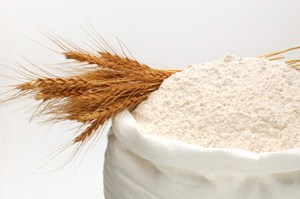
Nutritional Benefits of Vital Wheat Gluten
By Kenneth I. Burke, PhD, RD
Vital wheat gluten (also called gluten flour and vital gluten) is the isolated protein of wheat. Because it is a highly refined product, vital wheat gluten’s vitamin and mineral content is less than that of whole wheat. One tablespoon of vital gluten contains 33 calories, 1 gram of carbohydrate and 7 grams of protein. Although 75 percent protein, it is low in the essential amino acid lysine.*
On its own, vital wheat gluten is sodium-free, fat-free, saturated fat-free and contains no cholesterol. In the form of seitan or other meat analog, it is a good protein alternative for vegetarians or anyone looking for meat substitutes, particularly those who may be allergic to soy. However, people with celiac disease, gluten sensitivity or wheat allergies should take special care to read labels of these and other products, since vital wheat gluten may be included as an ingredient.
Traditionally, making vital wheat gluten was quite involved:
1. Wheat flour was mixed with water to make dough.
2. The dough was kneaded to develop the gluten strands.
3. The starch was extracted by gently washing the dough in cold water. (The solubility and dispersion of gluten is minimal in cold water).
4. The dough was then dried and ground into a powder or used to make meat analogs.
More recent vital wheat gluten production uses turbomilling to produce very fine particles, and air classification to separate the less dense starch granules from the more dense gluten granules, streamlining the process
Cooking with Vital Wheat Gluten
By Meredith Hink, MS, RD, CD
For the home baker who substitutes whole-grain flour in favorite bread recipes, adding vital wheat gluten can help them rise to the occasion by providing protein to stabilize the bread as it rises. Most recipes that include vital wheat gluten suggest one tablespoon per cup of flour.
Vital wheat gluten is also used to create flavorful meat substitutes (sometimes called “wheat meat”) commercially available in dried, canned, refrigerated or frozen forms at Asian food stores, health stores and some supermarkets.
One of the more common types of vital wheat gluten meat substitutes is seitan—a brand name that, since its introduction in the 1960s, has evolved into a common reference. Made by mixing vital wheat gluten with water and seasonings to form a dough, then boiling strips of the dough in flavored broth, seitan can be kept refrigerated in its cooking liquid for several days or frozen for several months to enjoy later. The texture of homemade seitan can range from spongy to chewy, depending on how long it is cooked, making it perfect for casseroles and salads, kabobs, stews and soups.
TIP: It is important when shopping to carefully read labels, as true vital wheat gluten is not always labeled consistently and similar products may have starch milled in with the gluten.
Using Vital Wheat Gluten in Food Service
By Bert C. Connell, PhD, RD, FADA
Although it is not considered a vital ingredient by all institutional kitchens, managers might consider adding vital wheat gluten to their operations.
Traditionally, bakers use high-protein flours (typically those milled from hard red winter wheat) to produce moist and tender bread, but today, more customers are asking for whole-grain breads. Adding vital wheat gluten to whole-grain bread dough increases leavening and can boost volume in breads containing dried fruits or nuts, but don’t add it to bakery goods such as muffins, cakes, biscuits or pastries that should have a soft or flaky texture.
In addition, vital wheat gluten can replace meat in fajitas, stir fry, stroganoff, stew or soup. These meat analogs may be substituted on a pound-for-pound edible portion basis for meat, without additional modification to the original recipe. Vital wheat gluten is a common ingredient in veggie crumbles that can be used instead of ground beef in shepherds pie, meatloaf, spaghetti sauce or chili. Vital wheat gluten also acts as a binding ingredient and adds a meaty, chewy texture to bean, lentil, chickpea or chopped mushroom veggie burgers.
Vital wheat gluten may be purchased from most full-service vendors in bags as large as 50 pounds. Storage requires a cool, dry location with storage temperature of 65 degrees F, which yields a two-year product life span.
*Note (7/15/15): This article has been edited and updated.
